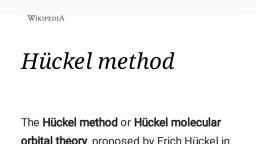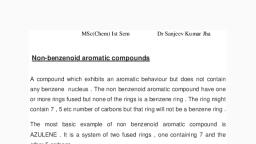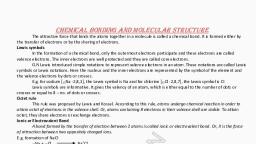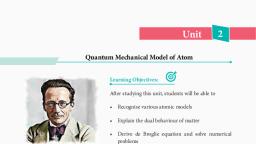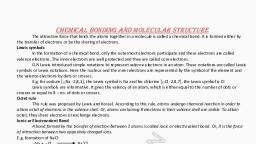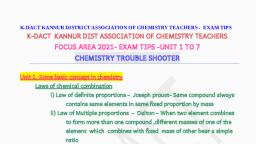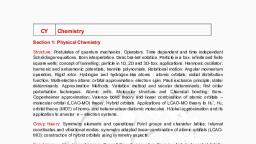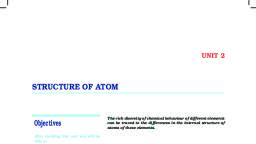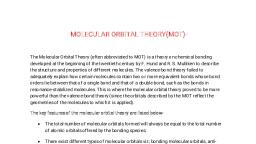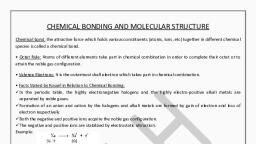Page 1 :
Hückel method, The Hückel method or Hückel molecular, orbital theory, proposed by Erich Hückel in, 1930, is a very simple linear combination, of atomic orbitals molecular orbitals, method for the determination of energies, of molecular orbitals of π-electrons in πdelocalized molecules, such as ethylene,, benzene, butadiene, and pyridine.[1][2] It is, the theoretical basis for Hückel's rule for, the aromaticity of, , π-electron
Page 2 :
cyclic, planar systems. It was later, extended to conjugated molecules such as, pyridine, pyrrole and furan that contain, atoms other than carbon, known in this, context as heteroatoms.[3] A more, dramatic extension of the method to, include σ-electrons, known as the, extended Hückel method (EHM), was, developed by Roald Hoffmann. The, extended Hückel method gives some, degree of quantitative accuracy for, organic molecules in general (not just, planar systems) and was used to provide, computational justification for the, Woodward–Hoffmann rules.[4] To, distinguish the original approach from
Page 3 :
Hoffmann's extension, the Hückel method, is also known as the simple Hückel, method (SHM). An elementary description, of the application of the simple Huckel, method to benzene is given in Sections, 3.4.3 and 10.2 of a student level text, book.[5], , In spite of its simplicity, the Hückel method, in its original form makes qualitatively, accurate and chemically useful predictions, for many common molecules and is, therefore a powerful and widely taught, educational tool. It is described in many, introductory quantum chemistry and
Page 4 :
physical organic chemistry textbooks, and, organic chemists in particular still routinely, apply Hückel theory to obtain a very, approximate, back-of-the-envelope, understanding of π-bonding., , Hückel characteristics, The method has several characteristics:, It limits itself to conjugated, hydrocarbons., Only π electron molecular orbitals are, included because these determine much, of the chemical and spectral properties, of these molecules. The σ electrons are
Page 5 :
assumed to form the framework of the, molecule and σ connectivity is used to, determine whether two π orbitals, interact. However, the orbitals formed by, σ electrons are ignored and assumed, not to interact with π electrons. This is, referred to as σ-π separability. It is, justified by the orthogonality of σ and π, orbitals in planar molecules. For this, reason, the Hückel method is limited to, systems that are planar or nearly so., The method is based on applying the, variational method to linear combination, of atomic orbitals and making, simplifying assumptions regarding the, overlap, resonance and Coulomb
Page 6 :
integrals of these atomic orbitals. It, does not attempt to solve the, Schrödinger equation, and neither the, functional form of the basis atomic, orbitals nor details of the Hamiltonian, are involved., For hydrocarbons, the method takes, atomic connectivity as the only input;, empirical parameters are only needed, when heteroatoms are introduced., The method predicts how many energy, levels exist for a given molecule, which, levels are degenerate and it expresses, the molecular orbital energies in terms, of two parameters, called α, the energy
Page 7 :
of an electron in a 2p orbital, and β, the, interaction energy between two 2p, orbitals (the extent to which an electron, is stabilized by allowing it to delocalize, between two orbitals). The usual sign, convention is to let both α and β be, negative numbers. To understand and, compare systems in a qualitative or, even semi-quantitative sense, explicit, numerical values for these parameters, are typically not required., In addition the method also enables, calculation of charge density for each, atom in the π framework, the fractional, bond order between any two atoms, and, the overall molecular dipole moment.
Page 8 :
Hückel results, Results for simple molecules and, general results for cyclic and linear, systems, , E…, , The results for a few simple molecules are, tabulated below:
Page 12 :
Energy levels, are, each doubly degenerate., Cyclic system, Möbius topology, (hypothetical for N < 8[8]):, , ., Energy levels, are, each doubly degenerate., The energy levels for cyclic systems can, be predicted using the Frost circle, mnemonic (named after the American, chemist Arthur Atwater Frost). A circle
Page 13 :
centered at α with radius 2β is inscribed, with a regular N-gon with one vertex, pointing down; the y-coordinate of the, vertices of the polygon then represent the, orbital energies of the, [N]annulene/annulenyl system.[9] Related, mnemonics exists for linear and Möbius, systems.[10], , The values of α and β, , E…, , The value of α is the energy of an electron, in a 2p orbital, relative to an unbound, electron at infinity. This quantity is, negative, since the electron is stabilized by, being electrostatically bound to the
Page 14 :
positively charged nucleus. For carbon this, value is known to be approximately –11.4, eV. Since Hückel theory is generally only, interested in energies relative to a, reference localized system, the value of α, is often immaterial and can be set to zero, without affecting any conclusions., Roughly speaking, β physically represents, the energy of stabilization experienced by, an electron allowed to delocalize in a π, molecular orbital formed from the 2p, orbitals of adjacent atoms, compared to, being localized in an isolated 2p atomic, orbital. As such, it is also a negative, number, although it is often spoken of in
Page 15 :
terms of its absolute value. The value for |, β| in Hückel theory is roughly constant for, structurally similar compounds, but not, surprisingly, structurally dissimilar, compounds will give very different values, for |β|. For example, using the π bond, energy of ethylene (65 kcal/mole) and, comparing the energy of a doublyoccupied π orbital (2α + 2β) with the, energy of electrons in two isolated p, orbitals (2α), a value of |β| = 32.5, kcal/mole can be inferred. On the other, hand, using the resonance energy of, benzene (36 kcal/mole, derived from heats, of hydrogenation) and comparing benzene, (6α + 8β) with a hypothetical "non-
Page 16 :
aromatic 1,3,5-cyclohexatriene" (6α + 6β),, a much smaller value of |β| = 18 kcal/mole, emerges. These differences are not, surprising, given the substantially shorter, bond length of ethylene (1.33 Å) compared, to benzene (1.40 Å). The shorter distance, between the interacting p orbitals, accounts for the greater energy of, interaction, which is reflected by a higher, value of |β|. Nevertheless, heat of, hydrogenation measurements of various, polycyclic aromatic hydrocarbons like, naphthalene and anthracene all imply, values of |β| between 17 and 20 kcal/mol.
Page 17 :
However, even for the same compound,, the correct assignment of |β| can be, controversial. For instance, it is argued, that the resonance energy measured, experimentally via heats of hydrogenation, is diminished by the distortions in bond, lengths that must take place going from, the single and double bonds of "nonaromatic 1,3,5-cyclohexatriene" to the, delocalized bonds of benzene. Taking this, distortion energy into account, the value of, |β| for delocalization without geometric, change (called the "vertical resonance, energy") for benzene is found to be around, 37 kcal/mole. On the other hand,, experimental measurements of electronic
Page 18 :
spectra have given a value of |β| (called, the "spectroscopic resonance energy") as, high as 3 eV (~70 kcal/mole) for, benzene.[11] Given these subtleties,, qualifications, and ambiguities, Hückel, theory should not be called upon to, provide accurate quantitative predictions –, only semi-quantitative or qualitative trends, and comparisons are reliable and robust., , Other successful predictions, , E…, , With this caveat in mind, many predictions, of the theory have been experimentally, verified:
Page 19 :
The HOMO–LUMO gap, in terms of the β, constant, correlates directly with the, respective molecular electronic, transitions observed with UV/VIS, spectroscopy. For linear polyenes, the, energy gap is given as:, , from which a value for β can be, obtained between −60 and −70 kcal/mol, (−250 to −290 kJ/mol).[12], The predicted molecular orbital energies, as stipulated by Koopmans' theorem, correlate with photoelectron, spectroscopy.[13]
Page 20 :
The Hückel delocalization energy, correlates with the experimental heat of, combustion. This energy is defined as, the difference between the total, predicted π energy (in benzene 8β) and a, hypothetical π energy in which all, ethylene units are assumed isolated,, each contributing 2β (making benzene, 3 × 2β = 6β)., Molecules with molecular orbitals paired, up such that only the sign differs (for, example α ± β) are called alternant, , hydrocarbons and have in common, small molecular dipole moments. This is, in contrast to non-alternant, hydrocarbons, such as azulene and
Page 21 :
fulvene that have large dipole moments., The Hückel theory is more accurate for, alternant hydrocarbons., For cyclobutadiene the theory predicts, that the two high-energy electrons, occupy a degenerate pair of molecular, orbitals (following from Hund's rules), that are neither stabilized nor, destabilized. Hence the square molecule, would be a very reactive triplet diradical, (the ground state is actually rectangular, without degenerate orbitals). In fact, all, cyclic conjugated hydrocarbons with a, total of 4n π-electrons share this, molecular orbital pattern, and this forms, the basis of Hückel's rule.
Page 22 :
Dewar reactivity numbers deriving from, the Hückel approach correctly predict, the reactivity of aromatic systems with, nucleophiles and electrophiles., The benzyl cation and anion serve as, simple models for arenes with electronwithdrawing and electron-donating, groups, respectively. The π-electron, population correctly implies the metaand ortho-/para-selectivity for, electrophilic aromatic substitution of π, electron-poor and π electron-rich arenes,, respectively.
Page 23 :
Delocalization energy, πbond orders, and π-electron, populations, The delocalization energy, π-bond orders,, and π-electron population are chemically, significant parameters that can be gleaned, from the orbital energies and coefficients, that are the direct outputs of Hückel, theory.[14] These are quantities strictly, derived from theory, as opposed to, measurable physical properties, though, they correlate with measurable qualitative, and quantitative properties of the chemical, species. Delocalization energy is defined, as the difference in energy between that of
Page 24 :
the most stable localized Lewis structure, and the energy of the molecule computed, from Hückel theory orbital energies and, occupancies. Since all energies are, relative, we set, , without loss of, , generality to simplify discussion. The, energy of the localized structure is then, set to be 2β for every two-electron, localized π-bond. The Hückel energy of the, molecule is, , , where the sum is, , over all Hückel orbitals,, , is the, , occupancy of orbital i, set to be 2 for, doubly-occupied orbitals, 1 for singlyoccupied orbitals, and 0 for unoccupied, orbitals, and, , is the energy of orbital i.
Page 25 :
Thus, the delocalization energy,, conventionally a positive number, is, defined as, , ., , π-Electron populations of benzyl cation and, benzyl anion can be used to rationalize the, directing group effects of electron-withdrawing, and -donating substituents in electrophilic, aromatic substitution.
Page 26 :
In the case of benzene, the occupied, orbitals have energies (again setting, ) 2β, β, and β. This gives the Hückel, energy of benzene as, . Each, Kekulé structure of benzene has three, double bonds, so the localized structure is, assigned an energy of, , . The, , delocalization energy, measured in units of, , is then, , ., , The π-bond orders derived from Hückel, theory are defined using the orbital, coefficients of the Hückel MOs. The πbond order between atoms j and k is, defined as
Page 27 :
,, where, , is again the orbital occupancy of, , orbital i and, , and, , are the, , coefficients on atoms j and k, respectively,, for orbital i. For benzene, the three, occupied MOs, expressed as linear, combinations of AOs, , ,[, , ,[, , ];, , ];, , , are:[15]
Page 28 :
,, [, , ]., , Perhaps surprisingly, the π-bond order, formula gives a bond order of, , for the bond between carbons 1 and 2.[16], The resulting total (σ + π) bond order of, is the same between any other pair of, adjacent carbon atoms. This is more than, the naive π-bond order of, , (for a total
Page 29 :
bond order of, , ) that one might guess, , when simply considering the Kekulé, structures and the usual definition of bond, order in valence bond theory. The Hückel, definition of bond order attempts to, quantify any additional stabilization that, the system enjoys resulting from, delocalization. In a sense, the Hückel bond, order suggests that there are four π-bonds, in benzene instead of the three that are, implied by the Kekulé-type Lewis, structures. The "extra" bond is attributed to, the additional stabilization that results, from the aromaticity of the benzene, molecule. (This is only one of several
Page 30 :
definitions for non-integral bond orders,, and other definitions will lead to different, values that fall between 1 and 2.), The π-electron population is calculated in, a very similar way to the bond order using, the orbital coefficients of the Hückel MOs., The π-electron population on atom j is, defined as, ., The associated Hückel Coulomb charge is, defined as, , , where, , is the number of π-electrons, contributed by a neutral, sp2-hybridized
Page 31 :
atom j (we always have, , for, , carbon)., For carbon 1 on benzene, this yields a πelectron population of, , ., Since each carbon atom contributes one πelectron to the molecule, this gives a, Coulomb charge of 0 for carbon 1 (and all, other carbon atoms), as expected., In the cases of benzyl cation and benzyl, anion shown above,
Page 32 :
and, ,, and, ., , Mathematics behind the, Hückel method, The mathematics of the Hückel method is, based on the Ritz method. In short, given a, basis set of n normalized atomic orbitals, , an ansatz molecular orbital, is written
Page 33 :
down, with normalization constant N and, coefficients, , which are to be determined., , In other words, we are assuming that the, molecular orbital (MO) can be written as a, linear combination of atomic orbitals, a, conceptually intuitive and convenient, approximation (the linear combination of, atomic orbitals or LCAO approximation)., The variational theorem states that given, an eigenvalue problem, with smallest eigenvalue, , and, , corresponding wavefunction, , , any, , normalized trial wavefunction, , (i.e.,, , holds) will satisfy
Page 34 :
,, with equality holding if and only if, . Thus, by minimizing, with respect to, coefficients, wavefunctions, , for normalized trial, , we obtain, , a closer approximation of the true groundstate wavefunction and its energy., To start, we apply the normalization, condition to the ansatz and expand to get, an expression for N in terms of the, , ., , Then, we substitute the ansatz into the, expression for E and expand, yielding
Page 35 :
, where, , ,, , and, ., In the remainder of the derivation, we will, assume that the atomic orbitals are real., (For the simple case of the Hückel theory,, they will be the 2pz orbitals on carbon.), Thus,, , , and because the
Page 36 :
Hamiltonian operator is hermitian,, . Setting, to minimize E and, , for, , collecting terms, we obtain a system of n, simultaneous equations, , ., When, , ,, , and, , are called the, , overlap and resonance (or exchange), integrals, respectively, while, , is called, , the Coulomb integral, and, expresses that fact that the, normalized. The n × n matrices, , simply, are, and
Page 37 :
are known as the overlap and, Hamiltonian matrices, respectively., By a well-known result from linear algebra,, nontrivial solutions, , to the, , above system of linear equations can only, exist if the coefficient matrix, is singular. Hence,, , must, , have a value such that the determinant of, the coefficient matrix vanishes:, . (*), This determinant expression is known as, the secular determinant and gives rise to a, generalized eigenvalue problem. The, variational theorem guarantees that the
Page 38 :
lowest value of, , that gives rise to a, , nontrivial (that is, not all zero) solution, vector, , represents the, , best LCAO approximation of the energy of, the most stable π orbital; higher values of, with nontrivial solution vectors, represent reasonable estimates of the, energies of the remaining π orbitals., The Hückel method makes a few further, simplifying assumptions concerning the, values of the, , and, , . In particular, it, , is first assumed that distinct, , have zero, , overlap. Together with the assumption that, are normalized, this means that the, overlap matrix is the n × n identity matrix:
Page 39 :
. Solving for E in (*) then, reduces to finding the eigenvalues of the, Hamiltonian matrix., Second, in the simplest case of a planar,, unsaturated hydrocarbon, the Hamiltonian, matrix, , is parameterized in the, , following way:, , (**), To summarize, we are assuming that: (1), the energy of an electron in an isolated, C(2pz) orbital is, , ; (2) the energy, , of interaction between C(2pz) orbitals on
Page 40 :
adjacent carbons i and j (i.e., i and j are, connected by a σ-bond) is, , ; (3), , orbitals on carbons not joined in this way, are assumed not to interact, so, for nonadjacent i and j; and, as mentioned, above, (4) the spatial overlap of electron, density between different orbitals,, represented by non-diagonal elements of, the overlap matrix, is ignored by setting, , even when the orbitals, , are adjacent., This neglect of orbital overlap is an, especially severe approximation. In, actuality, orbital overlap is a prerequisite, for orbital interaction, and it is impossible
Page 41 :
to have, , while, , . For, , typical bond distances (1.40 Å) as might, be found in benzene, for example, the true, value of the overlap for C(2pz) orbitals on, adjacent atoms i and j is about, ; even larger values are found, when the bond distance is shorter (e.g.,, ethylene).[17] A major, consequence of having nonzero overlap, integrals is the fact that, compared to noninteracting isolated orbitals, bonding, orbitals are not energetically stabilized by, nearly as much as antibonding orbitals are, destabilized. The orbital energies derived, from the Hückel treatment do not account
Page 42 :
for this asymmetry (see Hückel solution, for ethylene (below) for details)., The eigenvalues of, , are the Hückel, , molecular orbital energies, expressed in terms of, , ,, , and , while the, , eigenvectors are the Hückel MOs, , expressed as linear, combinations of the atomic orbitals, , ., , Using the expression for the normalization, constant N and the fact that, we can find the normalized MOs by, incorporating the additional condition, ., , ,
Page 43 :
The Hückel MOs are thus uniquely, determined when eigenvalues are all, distinct. When an eigenvalue is degenerate, (two or more of the, , are equal), the, , eigenspace corresponding to the, degenerate energy level has dimension, greater than 1, and the normalized MOs at, that energy level are then not uniquely, determined. When that happens, further, assumptions pertaining to the coefficients, of the degenerate orbitals (usually ones, that make the MOs orthogonal and, mathematically convenient[18]) have to be, made in order to generate a concrete set, of molecular orbital functions.
Page 44 :
If the substance is a planar, unsaturated, hydrocarbon, the coefficients of the MOs, can be found without appeal to empirical, parameters, while orbital energies are, given in terms of only, , and . On the, , other hand, for systems containing, heteroatoms, such as pyridine or, formaldehyde, values of correction, constants, , and, , have to be, , specified for the atoms and bonds in, question, and, by, , and, and, , in (**) are replaced, , respectively., , Hückel solution for ethylene, in detail
Page 45 :
Molecular orbitals ethylene, , In the Hückel treatment for ethylene, we, write the Hückel MOs, , as a linear, , combination of the atomic orbitals (2p, orbitals) on each of the carbon atoms:, ., , Molecular orbitals ethylene
Page 46 :
Applying the result obtained by the Ritz, method, we have the system of equations, , ,, where:, and, ., (Since 2pz atomic orbital can be expressed, as a pure real function, the * representing, complex conjugation can be dropped.) The, Hückel method assumes that all overlap
Page 47 :
integrals (including the normalization, integrals) equal the Kronecker delta,, , all Coulomb integrals, equal, and the resonance integral, nonzero when the atoms i and j are, bonded. Using the standard Hückel, variable names, we set, ,, ,, , and, ., The Hamiltonian matrix is, ., , are, is
Page 48 :
The matrix equation that needs to be, solved is then, ,, or, dividing by ,, , ., , Setting, , , we obtain, , . (***)
Page 49 :
This homogeneous system of equations, has nontrivial solutions for, (solutions besides the physically, meaningless, , ) iff the matrix, , is singular and the determinant is zero:, ., Solving for ,, , or, ., Since, , , the energy levels are, , or, .
Page 50 :
The coefficients can then be found by, expanding (***):, and, ., Since the matrix is singular, the two, equations are linearly dependent, and the, solution set is not uniquely determined, until we apply the normalization condition., We can only solve for, , in terms of, , :, , , or, ., After normalization with, numerical values of, found:, , and, , , the, can be
Page 51 :
and, , ., , Finally, the Hückel molecular orbitals are, , ., The constant β in the energy term is, negative; therefore,, , with, is the lower energy, , corresponding to the HOMO energy and, with, is the LUMO energy.
Page 52 :
If, contrary to the Hückel treatment, a, positive value for, , were, , included, the energies would instead be, ,, while the corresponding orbitals would, take the form, , ., An important consequence of setting, is that the bonding (in-phase), combination is always stabilized to a, lesser extent than the antibonding (out-of-
Page 53 :
phase) combination is destabilized,, relative to the energy of the free 2p orbital., Thus, in general, 2-center 4-electron, interactions, where both the bonding and, antibonding orbitals are occupied, are, destabilizing overall. This asymmetry is, ignored by Hückel theory. In general, for, the orbital energies derived from Hückel, theory, the sum of stabilization energies, for the bonding orbitals is equal to the sum, of destabilization energies for the, antibonding orbitals, as in the simplest, case of ethylene shown here and the case, of butadiene shown below., , Hückel solution for 1,3-
Page 54 :
butadiene, , Butadiene molecular orbitals, , The Hückel MO theory treatment of 1,3butadiene is largely analogous to the, treatment of ethylene, shown in detail, above, though we must now find the, eigenvalues and eigenvectors of a 4 × 4, Hamiltonian matrix. We first write the, molecular orbital, , as a linear
Page 55 :
combination of the four atomic orbitals, (carbon 2p orbitals) with coefficients, , :, ., , The Hamiltonian matrix is, , ., , In the same way, we write the secular, equations in matrix form as
Page 56 :
,, which leads to, , and, , , or approximately,, , where 1.618... and 0.618... are the
Page 59 :
and H. Bock, English translation, 1976,, Verlag Chemie., , The HMO-Model and its applications:, Problems with Solutions, E. Heilbronner, and H. Bock, English translation, 1976,, Verlag Chemie., , The HMO-Model and its applications:, Tables of Hückel Molecular Orbitals, E., Heilbronner and H. Bock, English, translation, 1976, Verlag Chemie., , References, 1. E. Hückel, Zeitschrift für Physik, 70, 204, , (1931); 72, 310 (1931); 76, 628 (1932); 83,, 632 (1933).
Page 60 :
2. Hückel Theory for Organic Chemists, C. A., , Coulson, B. O'Leary and R. B. Mallion,, Academic Press, 1978., 3. Andrew Streitwieser, Molecular Orbital, , Theory for Organic Chemists, Wiley, New, York (1961)., 4. "Stereochemistry of Electrocyclic, , Reactions", R. B. Woodward, Roald, Hoffmann, J. Am. Chem. Soc., 1965; 87(2);, 395–397. doi:10.1021/ja01080a054 ., 5. P. R. Bunker and P. Jensen, , (2005),Fundamentals of Molecular, Symmetry (CRC Press)ISBN 0-7503-09415 [1], . The chemical bond, 2nd ed., J.N. Murrel,, , S.F.A. Kettle, J.M. Tedder, ISBN 0-47190760-X
Page 61 :
7. Quantum Mechanics for Organic, , Chemists. Zimmerman, H., Academic, Press, New York, 1975.
Page 62 :
. Due to the twisted geometry required for a, , molecule to take on Möbius aromaticity,, the idealized Möbius versions of the, annulenes (or annulenyl ions) are, hypothetical species for small ring sizes., Three- to seven-membered Möbius, annulene/annulenyl systems are too, twisted to be reasonably considered as, stable species. Computations have, considered whether certain Möbius, topology isomers and conformers of, eight-membered and larger, annulene/annulenyl systems are aromatic., While Möbius aromatic configurations, have indeed been found, they are still, generally less stable than their, nonaromatic counterparts. The sole, exception appears to be trans-[9]annulenyl
Page 63 :
cation (trans-cyclo-C9H9+), whose ground, state is believed, on computational and, limited experimental grounds, to be, Möbius aromatic. In fact, there are only a, handful of ground state species that are, thought to be Möbius aromatic. However,, Möbius aromaticity is conceptually, important, as many pericyclic transition, states take on Möbius aromatic character,, and the distinction between Hückel and, Möbius topologies forms the basis of the, Dewar-Zimmerman approach to the, generalized pericyclic selection rules, (Woodward-Hoffmann rules).
Page 64 :
9. Frost, A. A.; Musulin, B. (1953)., , "Mnemonic device for molecular-orbital, energies". J. Chem. Phys. 21 (3): 572–, 573. Bibcode:1953JChPh..21..572F ., doi:10.1063/1.1698970 ., 10. Brown, A.D.; Brown, M. D. (1984). "A, , geometric method for determining the, Huckel molecular orbital energy levels of, open chain, fully conjugated molecules"., J. Chem. Educ. 61 (9): 770., Bibcode:1984JChEd..61..770B ., doi:10.1021/ed061p770 ., 11. Cotton, F. Albert (1990). Chemical, , Applications of Group Theory (3rd ed.)., New York: Wiley. pp. 438-440 . ISBN 9780471510949.
Page 65 :
12. "Use of Huckel Molecular Orbital Theory in, , Interpreting the Visible Spectra of, Polymethine Dyes: An Undergraduate, Physical Chemistry Experiment". Bahnick,, Donald A., J. Chem. Educ. 1994, 71, 171., 13. Huckel theory and photoelectron, , spectroscopy. von Nagy-Felsobuki, Ellak I., J. Chem. Educ. 1989, 66, 821., 14. Levine, Ira N. (2000). Quantum Chemistry, , (5th ed.). Upper Saddle River, N. J.:, Prentice Hall. pp. 629-649 . ISBN 0-13685512-1., 15. The "canonical" representatives of the, , doubly degenerate E1g orbitals (with nodal, planes through the x and y axes) are, shown here.
Page 66 :
1 . Rauk, Arvi (2001). Orbital Interactions in, , Organic Chemistry (2nd ed.). New York:, Wiley. pp. 92 . ISBN 0-471-35833-9., 17. Carroll, Felix A. (2010). Perspectives on, , Structure and Mechanism in Organic, Chemistry (2nd ed.). Hoboken, N.J.: Wiley., p. 179. ISBN 978-0-470-27610-5., 1 . Strictly speaking, the only requirement is, , for the coefficients to be chosen so that, linear combinations of the degenerate, MOs span the eigenspace corresponding, to that eigenvalue (energy level)., , Retrieved from, "https://en.wikipedia.org/w/index.php?, title=Hückel_method&oldid=993067473"
Page 67 :
Last edit ed 5 mont hs ago by Monkbot, , Content is available under CC BY-SA 3.0 unless, otherwise noted.





















